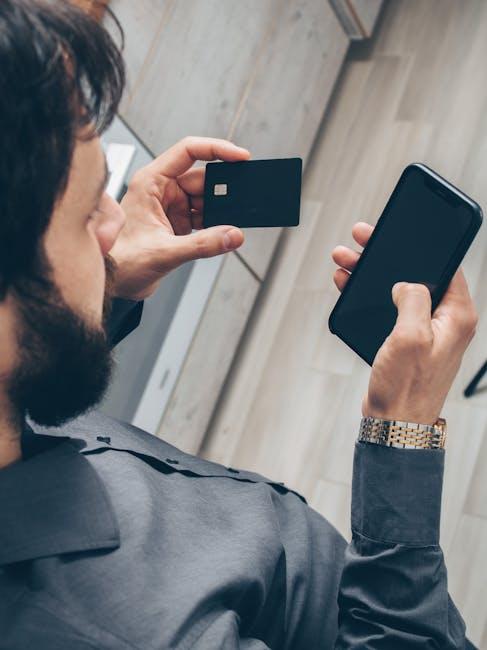In a world where convenience and security are paramount, the fusion of mobile technology and biometric payment systems is redefining how we exchange value. Gone are the days of fumbling for cash or swiping cards – now, a simple touch, glance, or even a pulse can authenticate transactions with unprecedented speed and precision. As smartphones become ever more sophisticated, embedding sensors that read fingerprints, facial features, and even vein patterns, the landscape of digital payments is evolving into a seamless, personalized experience. This article explores the transformative role mobile tech plays in advancing biometric payment systems, unraveling the innovations shaping the future of financial interactions.
Mobile Innovation Transforming Biometric Payment Security

As mobile technology evolves, it increasingly integrates with biometric payment systems to create seamless, secure transactions. These advancements utilize sophisticated sensors and algorithms embedded in smartphones, allowing for authentication methods like fingerprint scanning, facial recognition, and even voice identification. This convergence not only enhances security by reducing reliance on traditional PINs or passwords but also expedites the payment process, making mobile wallets more intuitive and user-friendly.
Key features propelling this shift include:
- AI-driven pattern recognition: Improves accuracy in biometric matching by learning individual user behaviors.
- Encrypted data storage: Ensures biometric information stays protected within the device’s secure enclave or trusted execution environment.
- Multi-factor authentication: Combines biometrics with device credentials for an extra layer of defense.
| Mobile Biometric Feature | Benefit |
|---|---|
| Fingerprint Scanner | Quick unlocking & payment approval |
| Facial Recognition | Hands-free authentication |
| Voice ID | Secure, contactless verification |
Enhancing User Experience Through Seamless Mobile Integration

Integrating biometric payment systems with mobile technology transforms transactions into a fluid, intuitive process that users can rely on whether they’re shopping in a bustling mall or tapping their phone to pay for coffee on the go. The core of this enhancement lies in minimizing friction-biometric authentication such as fingerprint scanning or facial recognition eliminates the need for passwords or PINs, speeding up payments while adding a layer of security. This seamless method not only reduces transaction times but also enhances user satisfaction by delivering a hassle-free experience across multiple devices and platforms.
- Instant verification: Touch or glance to authenticate without interrupting your flow.
- Cross-device compatibility: Syncs effortlessly with smartphones, wearables, and even smart home systems.
- Adaptive security: Dynamically adjusts based on user behavior and environment.
In terms of adaptability, mobile integration in biometric payments supports diverse user needs while maintaining secure performance under various conditions. For example, the table below highlights key mobile platforms and their biometric capabilities, demonstrating the versatility of modern systems:
| Platform | Biometric Options | Security Level | Average Auth Time |
|---|---|---|---|
| iOS | Face ID, Touch ID | High | ~1 second |
| Android | Fingerprint, Face Unlock | Medium-High | ~1.5 seconds |
| Wearables | Heart Rate, Gesture Recognition | Medium | ~2 seconds |
Addressing Privacy Concerns in Mobile Biometric Transactions

Ensuring the security of sensitive biometric data is paramount in fostering trust among users of mobile biometric payment systems. Developers and companies must adopt transparent data handling policies that clearly communicate how biometric information is collected, stored, and used. End-to-end encryption and decentralized storage techniques are becoming preferred methods to minimize the risk of data breaches. Additionally, biometric data should never be stored on centralized servers alone but rather be secured locally on the user’s device with hardware-level protection like Trusted Execution Environments (TEEs).
To further protect consumer privacy, regulatory compliance plays a crucial role. Mobile biometric payment providers often align with frameworks such as GDPR or CCPA to ensure personal data is processed responsibly. Key best practices include:
- Consent management – letting users explicitly approve data usage.
- Data minimization – collecting only the essential biometric markers needed for authentication.
- Regular audits – ensuring ongoing compliance and identifying vulnerabilities.
| Privacy Aspect | Implementation Example |
|---|---|
| Local Storage | Fingerprint data stored on device only |
| Encryption | End-to-end encryption between device and server |
| User Control | Options to delete biometric data instantly |
Best Practices for Implementing Mobile Biometric Payment Solutions

To harness the full potential of biometric payment systems, it is essential to prioritize user privacy and data security. Employing advanced encryption methods, such as end-to-end encryption and secure enclave technology, ensures that biometric data remains protected against unauthorized access. Developers should also implement rigorous multi-factor authentication regimes, combining biometrics with PINs or one-time passwords to balance convenience with security. Additionally, educating users about how their biometric data is stored and used helps build trust and encourages wider adoption of the technology.
Optimizing the user experience requires critical attention to device compatibility and speed. Implementing lightweight biometric algorithms that work seamlessly across a range of devices avoids alienating potential users with older hardware. Responsive interfaces that provide immediate feedback during the scanning process reduce friction and improve success rates. Below is a quick reference table outlining key performance indicators for an ideal mobile biometric payment solution:
| Feature | Optimal Measure |
|---|---|
| Authentication Speed | Under 2 seconds |
| False Rejection Rate (FRR) | Less than 1% |
| False Acceptance Rate (FAR) | Less than 0.1% |
| Energy Consumption | Minimal to conserve battery |
- Regular updates to biometric algorithms to tackle emerging fraud techniques.
- Compliance with global data privacy regulations, such as GDPR and CCPA.
- Seamless integration with popular mobile payment platforms for enhanced user convenience.
Wrapping Up
As mobile technology continues to evolve, its integration with biometric payment systems paints a future where convenience and security are seamlessly intertwined. From the tap of a fingerprint to the glance of an iris, these innovations are reshaping how we transact, making our devices not just tools, but trusted guardians of our financial identity. While challenges remain, the fusion of mobile tech and biometrics promises a world where payments are not only faster but intuitively personal-heralding a new era in the way we experience money.











